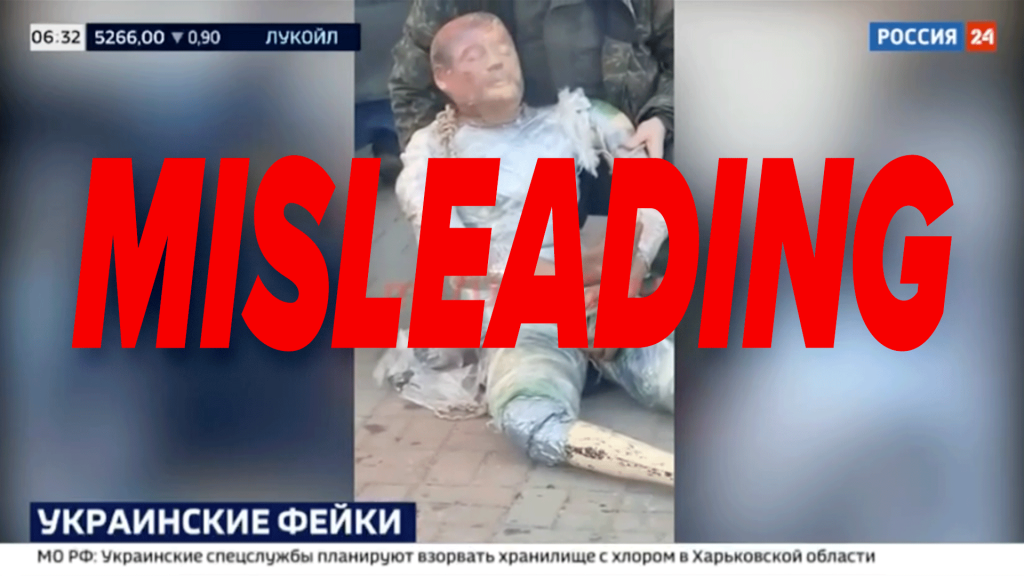Tracking narratives
Rossiya 24 broadcasts misleading video accusing Ukraine of using mannequins to stage war casualties
Falsified BBC News video spreads in Pro-Kremlin Telegram channels
Security
Situation intensifies in Mariupol
Media policy
Russian MP suggests 10-year YouTube ban
Kremlin accuses Google of displaying phrase “dead Russians” in translation results
Facing widespread social media restrictions, Kremlin creates new Telegram channel
Rossiya 24 broadcasts misleading video accusing Ukraine of using mannequins to stage war casualties
On April 7, Kremlin-controlled TV channel Rossiya 24 broadcast a video that it claimed was evidence of the Ukrainian military using mannequins to stage war casualties. However, the video was taken in Russia on a set of a TV series.
In the video, two men, one in a camouflage outfit resembling a military uniform and one in a green jacket, wrap a mannequin in tape. When Rossiya 24 aired the video, the anchor said it had been staged by Ukraine. “This is how preparations are going for the theater, in the truest sense of the word, military operation in Ukraine,” the anchor explained. “It seems everything is quite straightforward, two people in military uniform carefully wrap the mannequin with tape and, obviously, are going to pass it off as a corpse. However, this is not surprising, dozens of fakes with similar mannequins regularly appear in Ukrainian Telegram channels.”
The Rossiya 24 segment, “Crimes in Ukraine are disguised as ‘atrocities’ of the Russian army,” was reportedly also available on the streaming platform of the state-owned All-Russia State Television and Radio Broadcasting Company. The video disappeared from the platform on April 8.
The segment includes a watermark for the Russian pro-Kremlin Telegram channel U_G_M, which posted the video on April 6 with the caption, “This is how armed forces of Ukraine prepare their staged videos… these toys will be scattered along the streets of Kyiv or Nikolaev.” In the video, a man can be heard saying, “The dude will fly from the window, poor fellow.” Before Rossiya 24 aired the video, it was reposted in at least two other Telegram channels.
The day that Rossiya 24 aired the footage, it was revealed that the video was not filmed in Ukraine, but came from a TV series filmed in Vsevolozhsk, Russia, near Saint Petersburg. On April 7, Nadezhda Kolobaeva, the assistant director of the series, wrote on Facebook that the video aired by Rossiya 24 was recorded on March 20 as the TV crew prepped mannequins to fall from a window. Kolobaeva also posted behind-the-scenes photos and a video from the film set, referring to the dummy as “the most famous mannequin in the Russian Federation.”
Video from assistant director Nadezhda Kolobaeva showing a mannequin being dropped from a building while filming a TV series. (Source: Facebook)
On April 8, Russian journalist Roman Super said that he contacted Rossiya 24 requesting details about their report. He received a response stating that the channel director and editorial team did not “know that this was not Ukraine” and the video was “brought” to them. At the time of writing, Rossiya 24 had not publicly acknowledged the error.
—Givi Gigitashvili, Research Associate, Warsaw, Poland
Falsified BBC News video spreads in Pro-Kremlin Telegram channels
A graphic video purporting to be a BBC News report is being shared on pro–Kremlin Telegram channels. The BBC confirmed the video is fake. “We are aware of a fake video with BBC News branding suggesting Ukraine was responsible for last week’s missile attack on Kramatorsk train station,” the BBC News Press Team tweeted. “The BBC is taking action to have the video removed.”
The video in question falsely asserts that a missile’s serial number proves Ukraine shelled the Kramatorsk train station on April 8. The video claims that the “serial number of the Tochka-U missile” is identical to those used by the 13th Missile Brigade of the Ukrainian Armed Forces. Ukrainian fact-checking organization StopFake debunked this narrative on April 10.
The video claims that Ukrainian forces used missiles with the same serial number in Khartsyzsk, Berdyansk, Melitopol, and Logvynovo. It also falsely states that when the missile’s serial number was publicized on social media, Ukrainian media stopped reporting on the topic. The video cites “military experts” to claim that Ukraine “uses fake news to promote its position.”
The video includes an animated BBC logo, as well as a prompt at the end of the clip to download the BBC News app. It also features a number of oddities. For example, there are English spelling and grammar errors, such as “Ukraine has often started using fake news.” The BBC logo is placed suspiciously low in the video frame. The video also includes footage from TG LA7, an Italian news channel that was cited in a previously debunked disinformation narrative.
On Telegram, the DFRLab found at least thirty different channels sharing the video or screenshots of it. Kremlin–connected Telegram channels in Ukraine used the video to claim that the publication of the serial number forced Ukraine to stop discussing the matter. One channel urged a thorough investigation to take place to prevent such behavior from the Ukrainians.
Other pro-Kremlin channels shared the video as evidence that the BBC had acknowledged Ukrainian soldiers were behind the shelling. Another channel claimed that Ukraine has become toxic to its international partners, and this type of “proof” is the reason why the shelling of Kramatorsk train station was not a major news story in the West, suggesting Western media intentionally curtailed coverage of the incident. The attack received significant coverage for multiple days in Western media outlets.
—Roman Osadchuk, Research Associate
Situation intensifies in Mariupol
The situation in Mariupol continues to intensify as the Russian military increases pressure on the city’s remaining defenders. On April 12, a number of Ukrainian marines from the Rear Admiral Belinsky 36th Separate Brigade released a farewell video as they were running out of food and ammo. Reporting from Trukha News on the same day, however, suggested that several hundred marines, including the wounded, managed to break out of the enemy encirclement and connect with the Azov regiment in other parts of Mariupol.
Pro-Kremlin social media accounts also disseminated videos of Ukrainian soldiers surrendering, claiming they depict Ukrainian forces captured in Mariupol. The number of POWs vary from 160 to more than a thousand in these reports. The actual number of POWs remains unknown, however, and Kremlin sources may be exaggerating statistics.
On April 11, meanwhile, the Kyiv Independent and other Ukrainian sources reported that Russia deployed a poisonous substance against Ukrainian soldiers in Mariupol, allegedly distributed by a drone. While the incident is under investigation, no footage or forensic evidence of a chemical attack has emerged. Ukrainian sources also noted that on the same day, RIA Novosti quoted DNR politician Eduard Basurin saying that Russia needed to turn to “the chemical troops” to “lure the moles” in Mariupol.
On April 12, Vladimir Putin called out claims of chemical weapons use as “fake.” That same day, US President Joe Biden said that US would have a “proportional response” if Russia were to use chemical weapons.
—Lukas Andriukaitis, Associate Director, Brussels, Belgium
Russian MP suggests 10-year YouTube ban
According to the Kremlin-owned outlet RIA.ru, Russian State Duma member Alexey Chernyak plans to propose a draft law that would ban access to YouTube in Russia for ten years.
This comes after YouTube blocked the Russian parliament channel Duma TV for violating the video platform’s terms of service. Russian communications regulator Roskomnadzor requested YouTube restore access to the channel and explain why they blocked it.
Chernyak stated that YouTube’s block of Duma TV can be regarded as “censorship and a provocative violation of rights and freedoms, as well as a monopoly on the promotion of information.” Chernyak alleged that outlawing YouTube in Russia would result in “multi-million-dollar damage” for the company. He added that Duma TV will continue to convey information to Russians on domestic platforms.
—Eto Buziashvili, Research Associate, Washington DC
Kremlin accuses Google of displaying phrase “dead Russians” in translation results
On April 11, Roskomnadzor accused Google of “a violation of an extremist nature,” demanding the organization take immediate measures to remove “threats against Russian users.” Russia’s communications regulator claimed that when internet users entered the phrase “dear Russians” into Google Translate, the service offered to replace it with a translation of the phrase “dead Russians” instead.
According to Roskomnadzor, they “demanded that the American company take comprehensive measures to prevent such situations in relation to Russian users, as well as inform the agency about the reasons for such messages.” Both Reuters and the DFRLab attempted to replicate Roskomnadzor’s claims without success.
—Danielle Dougall, Young Global Professional, Washington DC
Facing widespread social media restrictions, Kremlin creates new Telegram channel
As social media platforms move to restrict access to Russian state-affiliated channels, the Kremlin has announced the creation of a new Telegram channel. The channel, Кремль. Новости (“Kremlin. News”), was created on April 4 but only became active on April 11.
Kremlin media outlets noted that the channel received a blue badge, signifying that Telegram had verified it. The channel primarily reposts information from the official Kremlin website. At the time of writing, the channel had 166,000 subscribers.
—Eto Buziashvili, Research Associate, Washington DC
Image: Rossiya TV video claiming to show Ukrainians dressing mannequins actually originated from behind-the-scenes footage of a Russian TV series. (Source: Rossiya TV)

